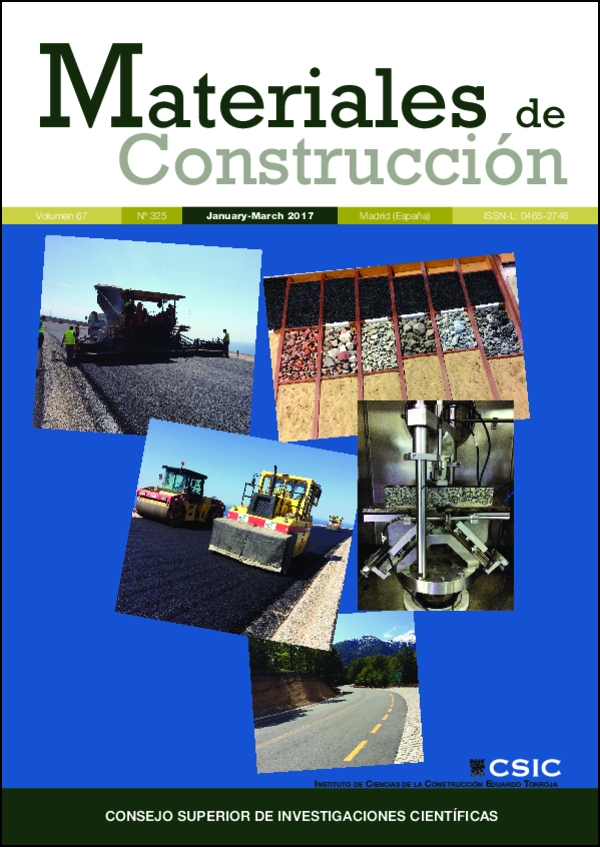Use of additives to improve the capacity of bituminous mixtures to be heated by means of microwaves
DOI:
https://doi.org/10.3989/mc.2017.00416Keywords:
Slag, Steel wool, Silicon carbide, Bituminous mixture, Microwave heatingAbstract
This study examines the potential of adding electric arc furnace slag to bituminous mixtures to be heated by microwaves. The susceptibility of bituminous mixtures to microwave energy is limited and so, in order to improve the energy performance of the heating process, it is necessary to incorporate additives or components to the mixture so as to improve the capacity for microwave heating. The article presents the results of adding various components, (steel wool, scrap tire wire, silicon carbide, iron filings) and an alternative aggregate: electric arc furnace slag. According to the results obtained in the laboratory, slag addition of at least 5% by weight of the bituminous mixture represents the best option for both technical and economic reasons. The results may promote the valorization of this steel industry residue in bituminous mixtures by improving microwave heating response.
Downloads
References
Vázquez, E.; Barra, M. (2001) Reactivity and expansion of electric arc furnace slag in their application in construction. Mater. Construcc. 51 [263-264], 137–148.
CEN. EN 13043/AC:2004. Aggregates for bituminous mixtures and surface treatments for roads, airfields and other trafficked areas.
Fernández, A.; Alonso, M.A.; López-Moro, F.J.; Moro, M.C. (2013) Polished Stone Value Test and its relationship with petrographic parameters (hardness contrast and modal composition) and surface micro-roughness in natural and artificial aggregates. Mater. Construct. 63 [311], 377–391. https://doi.org/10.3989/mc.2013.mc.00912
Asi, I.M. (2007) Evaluating skid resistance of different asphalt concrete mixes. Build. Environ. 42 [1], 325–329. https://doi.org/10.1016/j.buildenv.2005.08.020
Pasetto, M.; Baldo, N. (2011) Mix design and performance analysis of asphalt concretes with electric arc furnace slag. Constr.Build.Mater. 25 [8], 3458–3468. https://doi.org/10.1016/j.conbuildmat.2011.03.037
Bosisio, R.G.; Spooner, J.; Granger, J. (1974) Asphalt road maintenance with a mobile microwave power unit. J.Microwave.Power.EE. 9 [4], 381–386. https://doi.org/10.1080/00222739.1974.11688936
Al-Ohaly, A.A.; Terrel, R.L. (1988) Effect of microwave heating on adhesion and moisture damage of asphalt mixtures. Transport.Res.Rec. 1171, 27–36. Transportation Research Board. National Research Council. Washington, D.C.
Benedetto, A.; Calvi, A. (2013) a pilot study on microwave heating for production and recycling of road pavement materials. Constr.Build.Mater. 44, 351–359.
Wang, Z.J.; Zhao, P.; Ai, T.; Yang, G.Y.; Wang, Q. (2011) Microwave absorbing characteristics of asphalt mixes with carbonyl iron powder. Prog.Electromagn.Res. 19, 197–208.
Wang, Z.; Wang, S.; Ai, T.; Zhao, P. (2014) Laboratory preparation and microwave heating test of CIPs/Asphalt binder. Pavement Materials, Structures, and Performance GSP 239, 1–8. https://doi.org/10.1061/9780784413418.001
Gallego, J.; Del Val, M.A.; Contreras, V.; Páez A. Heating asphalt mixtures with microwaves to promote self-healing. Constr.Build.Mater. 42, 1–4.
Statistics 2010. Association of Metallurgical Producers and Processors. Duisburg-Rheinhausen, Germany.
ADECGLOBAL Eco-integración Ambiental. Ficha técnica de Producto. Marcado CE: Árido siderúrgico 9/5 GA85. In accordance with EN 13043:2002 + AC:2004.
CEN. EN 12591:2009. Bitumen and bituminous binders. Specifications for paving grade bitumens.
CEN. EN 12697-30:2006. Test methods for hot mix asphalt. Part 30: Specimen preparation by impact compactor.
CEN. EN 12697-6:2003. Bituminous mixtures. Test methods for hot mix asphalt. Part 6: Determination of bulk density of bituminous specimens.
CEN. EN 12697-34:2007. Bituminous mixtures. Test methods for hot mix asphalt. Part 34: Marshall Test.
Published
How to Cite
Issue
Section
License
Copyright (c) 2017 Consejo Superior de Investigaciones Científicas (CSIC)

This work is licensed under a Creative Commons Attribution 4.0 International License.
© CSIC. Manuscripts published in both the print and online versions of this journal are the property of the Consejo Superior de Investigaciones Científicas, and quoting this source is a requirement for any partial or full reproduction.
All contents of this electronic edition, except where otherwise noted, are distributed under a Creative Commons Attribution 4.0 International (CC BY 4.0) licence. You may read the basic information and the legal text of the licence. The indication of the CC BY 4.0 licence must be expressly stated in this way when necessary.
Self-archiving in repositories, personal webpages or similar, of any version other than the final version of the work produced by the publisher, is not allowed.
















